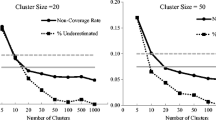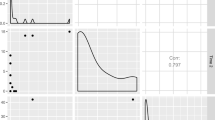Abstract
We consider one of the classical problems in statistics: the inference for the two-sample location problem. In this paper, we present a new empirical likelihood (EL) method for the difference of two smoothed M-estimators. To deal with additional nuisance scale parameters, we use the plug-in empirical likelihood, and we establish asymptotic properties of the new estimators. For the empirical study, we consider the important case of the smoothed Huber M-estimator. Our empirical results show that the new method is a competitive alternative to the classical procedures regarding inference about the difference of two location parameters. The software implementation for the new empirical likelihood method is based on the R package EL, which has been developed for related two-sample problems.
Similar content being viewed by others
References
Cers E, Valeinis J (2011) EL: two-sample empirical likelihood. R package version 1.0
Hall P, Welsh AH (1984) Convergence for estimates of parameters of regular variation. Ann Stat 12(3):1079–1084
Hampel F, Henning C, Ronchetti EA (2011) A smoothing principle for the Huber and other location M-estimators. Comput Stat Data Anal 55(1):324–337
Heritier S, Cantoni E, Copt S, Victoria-Feser MP (2009) Robust methods in biostatistics. Wiley, New York
Hjort NL, McKeague IW, Van Keilegom I (2009) Extending the scope of empirical likelihood. Ann Stat 37(3):1079–1111
Huber PJ (1964) Robust estimation of a location parameter. Ann Math Stat 35:73–101
Marazzi A (2002) Bootstrap tests for robust means of asymmetric distributions with unequal shapes. Comput Stat Data Anal 49:503–528
Maronna RA, Martin RD, Yohai VJ (2006) Robust statistics. Theory and methods. Wiley, New York
Owen AB (1988) Empirical likelihood ratio confidence intervals for a single functional. Biometrika 75(2):237–249
Owen AB (2001) Empirical likelihood. Chapman & Hall/CRC Press, New York
Qin J, Lawless J (1994) Empirical likelihood and general estimating equations. Ann Stat 22(1):300–325
Qin Y, Zhao L (2000) Empirical likelihood ratio confidence intervals for various differences of two populations. J Syst Sci Complex 13(1):23–30
Stigler SM (1977) Do robust estimators work with real data? Ann Stat 5(6):1055–1098
Valeinis J (2007) Confidence bands for structural relationship models. Ph. D. thesis, University of Goettingen, Goettingen
Valeinis J, Cers E, Cielens J (2010) Two-sample problems in statistical data modelling. Math Modell Anal 15:137–151
Wasserman L (2006) All of nonparametric statistics. Springer, New York
Wilcox R (2005) Introduction to robust estimation and hypothesis testing, 2nd edn. Elsevier Academic Press, Burlington
Acknowledgements
Janis Valeinis acknowledges partial support from the project 2009/0223/1DP/1.1.1.2.0/09/ APIA/VIAA/008 of the European Social Fund. We also want to thank Edmunds Cers for his programming assistance.
Author information
Authors and Affiliations
Corresponding author
Additional information
Publisher's Note
Springer Nature remains neutral with regard to jurisdictional claims in published maps and institutional affiliations.
Appendix: Proofs
Appendix: Proofs
At first, we present one technical Lemma.
Lemma 4
Suppose \(1/3< \eta < 1/2\) and Assumption 3 is satisfied. Then
uniformly around \(\theta \in \lbrace \theta : |\theta -\theta _0| \le cn_1^{-\eta }| \rbrace\) , where c is some positive constant.
For the proof of Lemma 4, see [12].
Proof of Theorem 2
Denote \(\hat{\lambda }_1= \lambda _1(\Delta ,{{\hat{\theta }},} {\hat{\sigma }}_1,{\hat{\sigma }}_2)\), \(\hat{\lambda }_2=\lambda _2(\Delta ,{{\hat{\theta }}}, {\hat{\sigma }}_1,{\hat{\sigma }}_2)\).
First, we show that given the root \({\hat{\theta }}={\theta }(\Delta ,{\hat{\sigma }}_1,{\hat{\sigma }}_2)\) of (3.3), the following holds:
where
Consider
Then we have
By Taylor expansion, we have
Hence
From conditions (C1)–(C3) of Assumption 3, it follows
Thus
where
and
Then, we have
Note that according to Assumption 3 it holds that
The statements (5.1)–(5.3) follow.
By Assumption 1 (A2), \(\psi ^3 \left( \frac{X_i-{\hat{\theta }}}{{\hat{\sigma }}} \right)\) is bound by some integrable function \(G_1(X)\). Thus \(\mathop {E} |\psi ( (X_i-{\hat{\theta }})/{\hat{\sigma }}_1) |^3\) exists, which is equivalent to
see, for example, [9]. It follows by the Borel–Cantelli lemma that \(|\psi ( (X_i-{\hat{\theta }})/{\hat{\sigma }}_1)|< n_1^{1/3}\) with probability 1. This implies that
Thus, using Lemma 4 with \(\eta \in (1/3; 1/2)\) we have
and with \(\xi \in \left[ 0, {\hat{\lambda }}_1 \psi \left( \frac{X_i-{\hat{\theta }}}{{\hat{\sigma }}_1} \right) \right]\) we have by the law of large numbers that
Thus, the following holds
A similar argument can be made for \({\hat{\lambda }}_2\). Then, using Taylor expansion for \(\log (1+x)\), we have
where
From (3.2), we have
The absolute value of the last term is bounded by
Thus, it follows (using a similar argument for \({\hat{\lambda }}_2\)) that
Hence from (5.5), we have
From condition (C3) of Assumption 3, we have
and using (5.2)
Using (5.3), we have
Then
which proves Theorem 2. \(\square\)
Proof of Lemma 1
We will present the proof only for the sample X, as for Y the result can be obtained similarly. Condition (A2) of Assumption 1 states that \(\psi '\) is bounded by some integrable function; thus, the expectation exists and condition (C1) of Assumption 3 holds by the law of large numbers. To prove (C2) and (C3), we follow the technique used in [8, Section 10.6] to establish the asymptotic distribution of the location M-estimates with a preliminary scale. Denote \(u_i=X_i-\theta _0\) and \({\hat{\sigma }}_1=\sigma _1^0+\delta\). Expand \({{\psi }} (u_i/{\hat{\sigma }}_1)\) to the second-order Taylor series around \(\theta _0\):
Summing over i and dividing by \(\sqrt{n_1}\), we obtain
where
\(E \psi (u_i/\sigma _1^0) = 0\) by the definition of the M-estimator, thus \(\sqrt{n_1} A_{n_1} \xrightarrow {d} N(0,V_1)\) by (B2). According to (B3), \(\sqrt{n_1} B_{n_1}\) tends to a normal distribution by the central limit theorem, and since \(\big (1- \frac{\sigma _1^0}{{\hat{\sigma }}_1} \big ) \rightarrow 0\) by condition (B1), the second term in the right-hand side of (5.7) tends to zero by Slutsky’s lemma. Hence, we obtain (C2).
Now, we expand \({{\psi }} (u_i/ {\hat{\sigma }}_1)\) around \(\theta _0\):
Summing over i and dividing by \(n_1\),
where
By the central limit theorem and (B2), \(C_{n_1}\) tends to \(V_1\), \(D_{n_1}\) tends to a constant by assumption (B4), and \(\big (1- \frac{\sigma _1^0}{{\hat{\sigma }}_1} \big ) \rightarrow 0\). Hence we obtain (C3). \(\square\)
Proof of Lemma 3
First, we verify that Assumption 1 condition (A2) holds. The derivative \({\tilde{\psi }}_k'\) is continuous due to the general smoothing principle of M-estimators established in (2.5). Next, \(0 \le {\tilde{\psi }}_k'(x) \le 1\) and \(0 \le {\tilde{\psi }}_k^3(x) \le k^3\), thus they are bounded.
Now, we verify that conditions of Assumption 2 hold. (B1) holds for MAD, \({\hat{\sigma }}_1=\text {MAD}=\mathop {Med}\{|X-\mathop {Med}(X)|\}\) under mild (smoothness) conditions on the underlying distribution F (see for example [2]). (B2) holds because \({\tilde{\psi }}_k\) with \(k<\infty\) is a bounded \(\psi\)-function. For \(F_1\) symmetric, \(\theta _0\) coincides with the center of symmetry and, since \({\tilde{\psi }}_k\) is odd, (B3) holds. Next, as \({\tilde{\psi }}'_k(x)=0\) for \(|x|>k\), for \(F_1\) symmetric (B4) is an expectation of an even and bounded function; hence, it is finite. \(\square\)
Rights and permissions
About this article
Cite this article
Velina, M., Valeinis, J. & Luta, G. Empirical Likelihood-Based Inference for the Difference of Two Location Parameters Using Smoothed M-Estimators. J Stat Theory Pract 13, 34 (2019). https://doi.org/10.1007/s42519-019-0037-8
Published:
DOI: https://doi.org/10.1007/s42519-019-0037-8




